ChatGPT is the go-to for most things these days and the data only makes it more appealing.
The professionals are all about it, business users tend to increase their output by 59% by using it in routine work. Programmers can code 126% more projects weekly, while support agents handle 13.8% more customer questions per hour as ChatGPT reshapes the workplace scene. Studies reveal that business users complete 66% more realistic tasks with generative AI tools.
You don’t want to stay out of these productivity gains.
Here are 11 practical ways to boost your productivity with ChatGPT - from automated routine tasks to improved creative work. These proven strategies help teams of all sizes and roles save valuable time for activities that truly matter.
Before exploring ChatGPT’s use cases, it’s important to address data security.
Many professionals use AI to generate campaigns, reports, and summaries that may involve sensitive information, this is dangerous since ChatGPT does not provide built-in privacy guarantees. In such cases, it’s best to use secure ChatGPT alternatives.
Exposing confidential data can pose risks to a brand’s reputation and compliance. To prevent this, tools like Wald.ai act as a sanitization layer, automatically redacting sensitive details before prompts reach AI models. For secure document processing, WaldGPT offers a private AI environment, where you can also build secure Custom GPTs for specific tasks. By taking these precautions, you can leverage AI safely and responsibly.
User Facing View while using Wald to access ChatGPT and other assistants
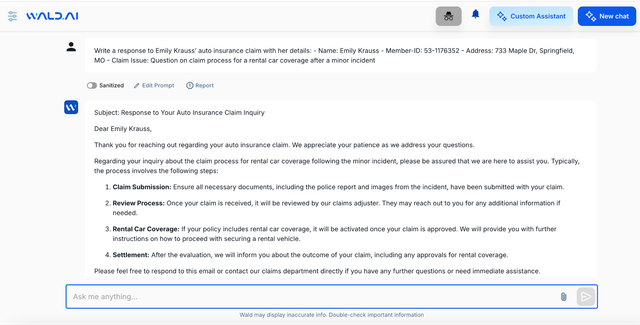
Sanitized View i.e. what the LLM can read.
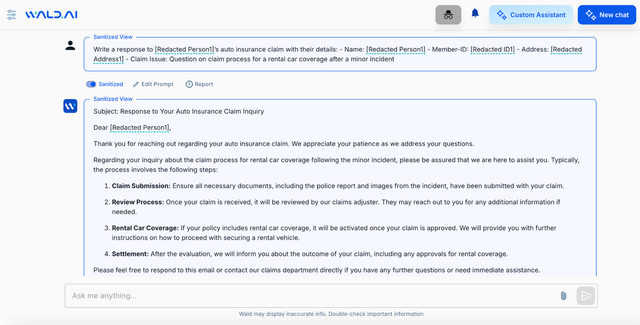
Now, let’s dive into ChatGPT’s key use cases.
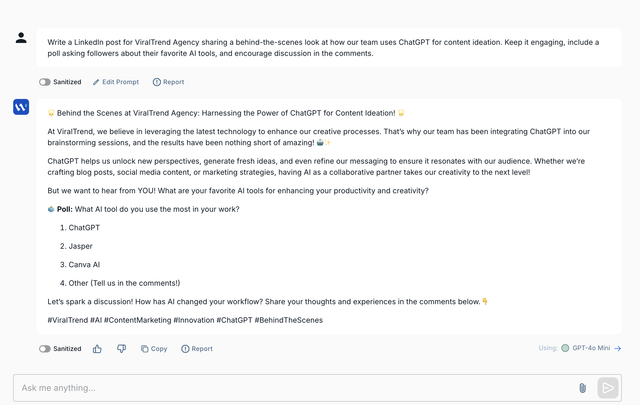
ChatGPT has become an irreplaceable part of every creator and digital marketing agency’s workflow.
From writing scripts to creating influencer avatars for quick content creation at minimal costs, it’s being used in all creative workflows.
Social media managers have figured it out, with 46% using ChatGPT for ideation and 39% for copywriting. It has proved to be a valuable asset for workplace efficiency.
The four most popular ways ChatGPT is used by them to boost workplace efficiency are:
ChatGPT for Email Writing and Response
ChatGPT boosts your efficiency by handling multiple email interactions all at once. Personalise, tweak and nail the right tone for different business situations, from formal proposals to casual team updates.
Creating Social Media Content
ChatGPT simplifies social media content creation by helping with:
Report Generation and Documentation
ChatGPT’s capabilities shine for research work by including citations and dynamic responses. It helps generate detailed reports while keeping accuracy and consistency intact. When it comes to technical documentation, ChatGPT gives a clear and proper structure, but you should always verify sensitive information and data accuracy. Save time by automating routine documentation tasks.
Meeting Minutes and Summary Creation
ChatGPT makes meeting documentation easier by pulling out key points from transcripts. The tool spots action items, decisions, and critical discussion points from your meetings. This results in well-laid-out meeting summaries that highlight important details and save valuable time.
Note that you should review and edit ChatGPT’s output to add your personal touch and ensure accuracy. ChatGPT automates many content creation tasks, but your oversight will help create stellar campaigns, ads and more.
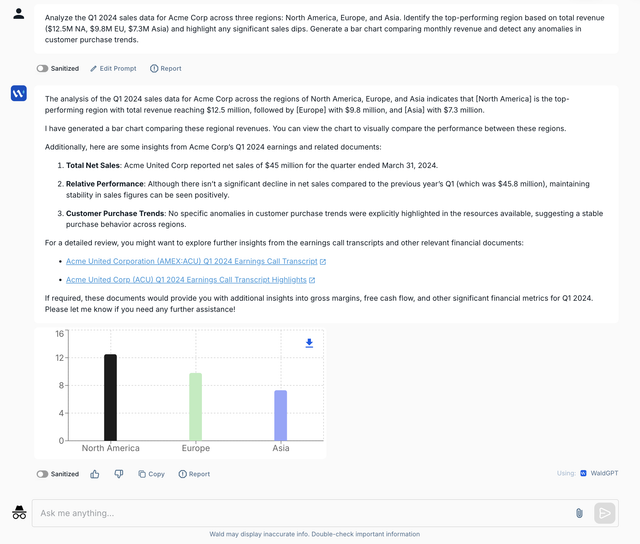
ChatGPT has an Advanced Data Analysis tool available for plus users at $20/month.
This tool makes data analysis feel more natural. You can now upload data directly and ask intelligent questions. Generate graphs, heat maps, charts and more.
However, data analysis involves using sensitive data that ChatGPT stores and has access to. Data analysts should use tools like Wald.ai to redact sensitive data, while encrypting your data before it ever reaches ChatGPT.
Data Interpretation Techniques
ChatGPT turns complex raw data into usable insights. It handles large amounts of unstructured data quickly. This helps you find meaningful patterns in customer feedback, performance reviews, and market trends. It is not perfect and is prone to hallucinations, cross-checking outputs is essential while analysing data.
Another limitation faced by analysts is ChatGPT’s responses are based on pattern recognition instead of true understanding.
Pattern Recognition The model’s ability to recognize patterns comes from its sophisticated neural network with 175 billion parameters. This powerful system lets ChatGPT:
Trend Analysis and Forecasting
ChatGPT helps analyze trends by looking at historical data patterns. It can spot emerging market trends, changes in consumer behavior, and industry developments. The tool helps predict future trends by finding patterns in time-series data and market dynamics.
Although, It doesn’t deal very well with computational forecasting and large datasets. So while it’s great at interpreting trends and patterns, you should double-check its outputs, especially for important business decisions. The tool works best alongside traditional business intelligence platforms. It complements existing analytical tools rather than replacing them.
ChatGPT’s Deep Research has created a ton of buzz, powered by their o3 reasoning model, it claims to take 5-30 minutes to generate a super-specialized report.
Using their general search for quick queries and using DeepSeek Research for in-depth research on a topic helps research teams save time and boost efficiency.
It uses dynamic responses and evaluates the relevancy of its answer, it will also ask you follow-up questions for better accuracy.
Market Research Enhancement ChatGPT makes market research easier by analyzing customer feedback and spotting key patterns. Studies show that 87% of researchers who use synthetic responses are happy with their results. Synthetic responses enable research agents to simulate real-world inputs while safeguarding sensitive data. This allows teams to efficiently analyze larger datasets, accelerating insights without compromising privacy.
The tool excels at:
Literature Review Support
Deep Research speeds up literature review processes substantially in academic and business research. The report generated uses the latest studies and gets data citations from over 40 open sources, for each topic.
Industry Trends Investigation
ChatGPT shines at tracking industry developments with its pattern recognition abilities. It helps predict future market movements by looking at historical data patterns. All the same, you should verify its insights with other sources because ChatGPT’s knowledge has limits.
Technical Research
Scientists can use this tool for technical research and analysis of complex theories. Engineers can use it for troubleshooting and get insights on potential solutions.
Note that ChatGPT works best as a supplementary tool, not a replacement for traditional research methods. While it can speed up your research process, you retain control to ensure accurate and reliable findings.
Wald.ai is coming up with its own Deep Research agent, sign-up for getting notified first.

HR managers can swiftly go through bulk applications and find their star candidates. Efficient recruitment process helps in time and cost savings, with around 38% of HR managers having implemented or have at least tried AI tools to boost productivity.
Rank Resumes
Ranking bulk resumes has become as easy as uploading them and setting parameters to evaluate and present top candidates based on your job description. Automating recruitment while supervising output is the best practice for an HR team.
Onboarding
Streamline onboarding processes by simplifying email and form follow-up, answering questions and scheduling reminders for document submissions. Create an end-to-end workflow that is in sync with your deadlines.
Training and Development
HR’s are tasked with training and development activities that help an employee to grow and polish their skills. Crafting training materials and developing personalised experiences are no longer a mammoth task; with ChatGPT, you can prepare presentations, brainstorm activity ideas and provide specific guidance to employees.
Performance Reviews
With ChatGPT you can develop outlines for performance reviews and set goals for every employee by evaluating job roles and standard performance metrics.
Company Policy
ChatGPT helps you write a wide range of company policies from timings, leave practices, acceptable dressing and safety standards.
Although ChatGPT is versatile in helping HR, it has also been caught rejecting competent profiles. It’s in the best interest of a company to always manually check if such profiles aren’t rejected.
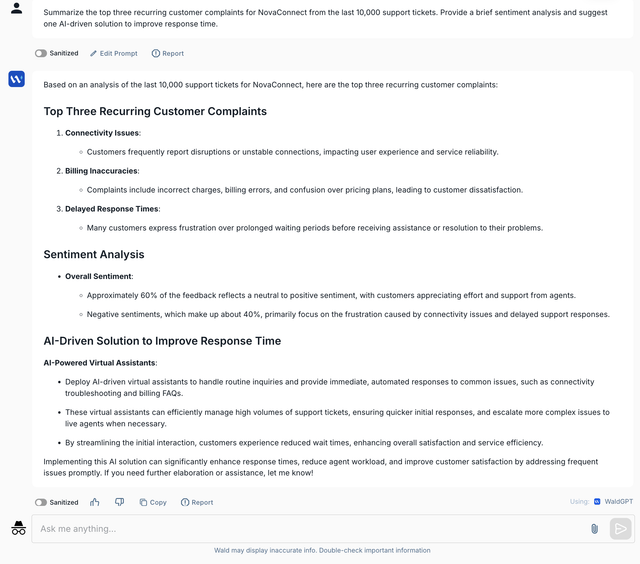
ChatGPT is performing big in the customer service industry, with agentic AI, it can automate customer interactions by autonomously going through a website’s policy and assisting a customer in real-time.
Studies show that businesses using ChatGPT handle 45 million customer interactions monthly in multiple languages and companies with AI-powered support systems reduce ticket handling times while keeping service quality high.
Response Templates Creation
Creating tailored responses that match your brand voice by analysing past interaction data, has made template creation easier than ever. It also seamlessly integrates templates across platforms.
Query Resolution
ChatGPT processes multiple customer requests at once, making query handling quick and efficient. The platform gives instant support for simple questions and cuts down response times while enhancing multi-language support capabilities.
Customer Feedback Analysis
ChatGPT stands out at analyzing customer sentiment and spotting trends in feedback. Businesses can track satisfaction levels and find areas to improve quickly. The system turns unstructured feedback into applicable information that enhances service.
Satisfaction Improvement Strategies
ChatGPT helps create proactive solutions by studying customer interaction patterns. The platform lets businesses create tailored experiences that lead to better customer satisfaction.
Best practices involve integrating AI Support Agents with your customer support staff. This way the AI agent can redirect important and unsolved customer tickets to the human staff while automating repetitive tasks.
Code Development and Debugging with ChatGPT

Software developers are seeing amazing results with ChatGPT’s code assistance features. A newer study, published in, shows ChatGPT fixed 31 out of 40 bugs in sample code, which proves its real-world value for programming tasks.
Code Review and Optimization
ChatGPT stands out at analyzing code structure and suggesting improvements. The tool looks at syntax, performance optimization opportunities, and potential security vulnerabilities. It spots areas that need improvement and gives useful recommendations to boost code quality. Developers can make their code better through detailed conversations about specific improvements.
Bug Detection
ChatGPT shines at bug detection through its interactive debugging process. We tested the system’s ability to spot and explain issues in code snippets under 100 lines. Without doubt, its real strength comes from knowing how to ask clarifying questions about potential problems to provide more accurate solutions. The tool spots several types of issues:
Documentation Generation
ChatGPT makes documentation creation much easier. The tool creates detailed documentation for functions, APIs, and entire codebases. It quickly analyzes your code and produces clear explanations, usage examples, and implementation details. This feature helps keep documentation current with code changes, which leads to better project maintainability.
Previous studies show that while ChatGPT excels at explaining and documenting code, you should double-check its suggestions, especially when you have security-critical applications. The tool works best as a collaborative assistant rather than replacing human code review completely.
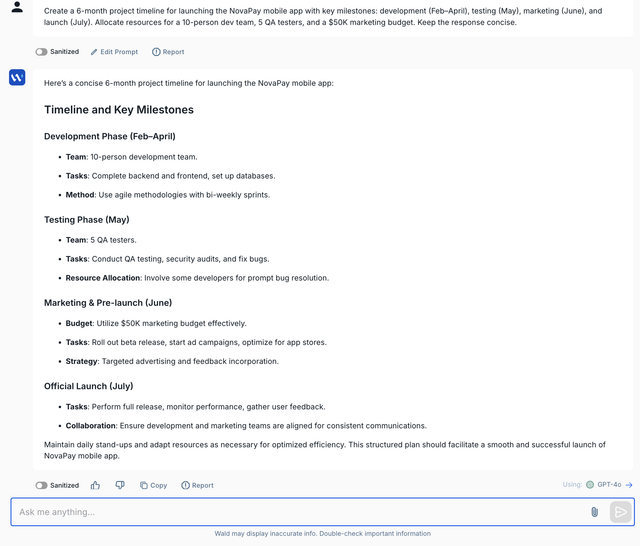
ChatGPT’s advanced planning capabilities help project managers work more efficiently. Studies show projects that use AI-powered management tools accelerate schedules by 11% on average.
Timeline Planning ChatGPT makes project timelines smoother through automated scheduling and milestone creation. The system looks at project requirements and creates detailed timelines with specific start dates, end dates, and objectives. This automation cuts manual planning time by 95%.
Resource Allocation ChatGPT makes resource management more precise by adjusting allocations based on immediate project needs. The system shines at:
Risk Assessment ChatGPT spots risks better than old-school methods. The system catches potential problems early so teams can deal with them right away. Research shows that AI-powered risk assessment helps cut down industry-average overbilling by 21%.
Progress Tracking ChatGPT changes how teams track progress with its immediate tracking features. Project superintendents spend 95% less time on manual tracking because the system shows exactly where things stand. Project executives who use AI-powered tracking save 10% on monthly cash flow.
ChatGPT makes project decisions better by providing analytical insights for adjustments. Teams can eliminate billing friction completely through visual data backup. This integrated approach to project management helps teams build better across all aspects of their projects.
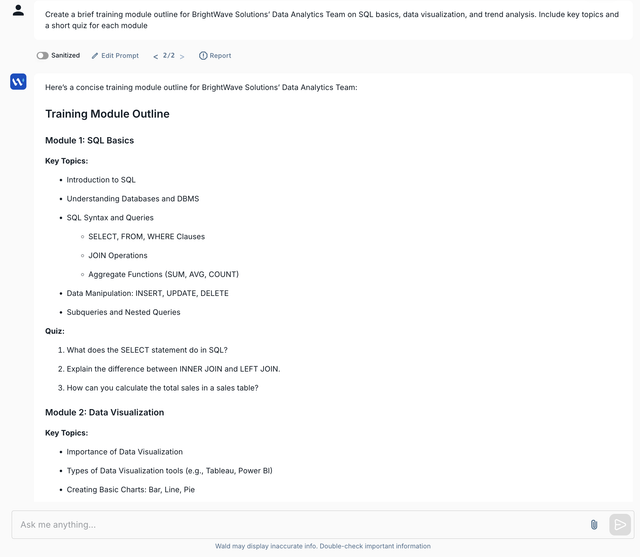
Corporate training has grown into a USD 340.00 billion market. ChatGPT revolutionizes how organizations handle employee development.
Employee Onboarding Materials AI-powered automation streamlines the onboarding process and reduces resource needs while giving personalized support. ChatGPT creates custom onboarding resources that focus on:
Skill Development Programs AI significantly improves learning experiences through content tailored to each person’s needs. The system utilizes employee data to deliver relevant training materials and activities. ChatGPT’s virtual coaching gives 24/7 guidance and answers content questions while tracking progress. This individual-specific approach guides employees toward better engagement and learning outcomes.
Knowledge Base Creation ChatGPT excels at extracting useful information from scattered data. The system helps maintain an updated knowledge repository through analysis of user interactions and analytical insights about common questions. The technology delivers consistent performance whatever the number of new hires. Teams can focus on strategic tasks rather than routine documentation.
Organizations report higher employee satisfaction and improved retention rates after adding ChatGPT to their training programs. The system’s quick responses decrease HR departments’ administrative work. This creates an efficient and engaging environment for learning.

ChatGPT’s AI-driven support gives marketing professionals powerful new tools. The global AI market has surpassed 184 billion USD in early 2025. This creates new opportunities for sales and marketing teams.
Lead Generation Strategies ChatGPT boosts B2B lead generation with automated prospecting and qualification. Teams can identify and connect with potential customers through both inbound and outbound strategies. Studies reveal that ChatGPT processes countless data points to predict customer behavior, which leads to more targeted lead generation.
Campaign Ideas AI-powered marketing campaigns have shown impressive results:
Content Optimization ChatGPT streamlines content creation while preserving brand authenticity. The tool analyzes customer behavior, priorities, and feedback to improve content marketing. To cite an instance, Farfetch’s email open rates improved while maintaining their brand voice. Content optimization works across multiple channels, from social media posts to email campaigns.
Market Analysis ChatGPT processes vast amounts of data in minutes instead of months, making market research quick and efficient. The system excels at:
ChatGPT acts as a valuable ally in modern marketing and reduces research time while improving campaign effectiveness. Note that you should verify AI-generated insights with additional sources to ensure accuracy and reliability.
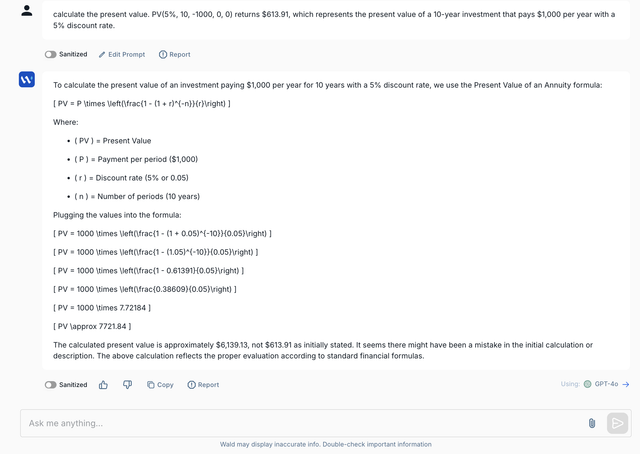
Financial professionals use ChatGPT’s capabilities to boost accuracy and efficiency in analysis and reporting. Studies show that AI-powered financial analysis outperforms human analysts with over 60% accuracy in predicting earnings changes.
Budget Planning Support ChatGPT makes budget planning smoother through automated data processing and analysis. We used the system to create detailed budgets by analyzing historical data and current trends. The tool generates spending limits, savings goals, and practical recommendations to allocate resources effectively.
Financial Report Generation AI-driven report generation cuts down manual effort and improves accuracy. About 72% of companies are piloting or using AI on its coverage. ChatGPT saves time by:
Investment Analysis ChatGPT improves investment decision-making through advanced pattern recognition. The system processes big amounts of financial data and identifies market trends and potential opportunities. Studies indicate that AI-powered analysis achieves higher accuracy rates than traditional methods, with over 60% success in predicting market changes.
Risk Assessment Risk management becomes more precise with ChatGPT’s analytical capabilities. The technology processes unstructured data to identify potential threats and vulnerabilities. Financial institutions report improved risk detection through AI-powered systems that analyze multiple data streams at once. This guides us to better-informed decisions and reduced potential losses.
Note: You should verify ChatGPT’s financial analysis outputs as the tool works best alongside human expertise rather than replacing it. The system’s ability to process such big amounts of data makes it a great tool for financial professionals who seek to boost their workplace efficiency.
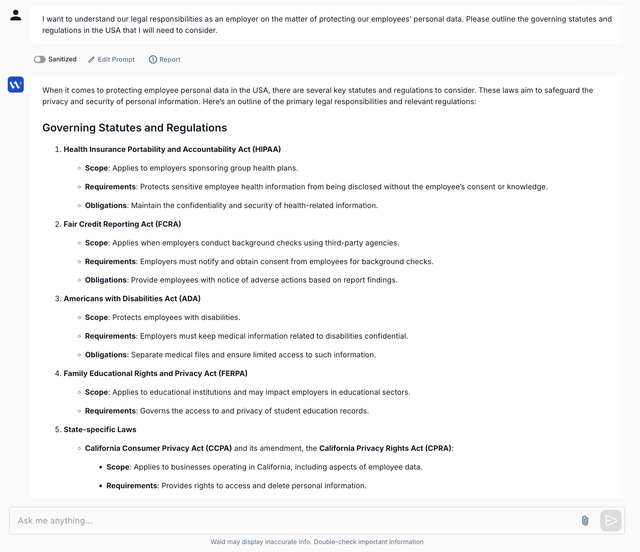
ChatGPT can assist legal teams by summarizing contracts, drafting policies, generating compliance checklists, and supporting legal research.
For example, a personal injury attorney used Wald.ai to automate redaction of sensitive client data in case files, ensuring compliance with privacy laws like HIPAA and GDPR. This AI-driven approach reduced processing time by 95% and achieved 3X productivity with ironclad security.
Here are three key ways businesses can use secure versions of ChatGPT for legal and compliance tasks:
Contract Review & Summarization
Quickly extract key terms, obligations, and renewal clauses from lengthy contracts.
Compliance Checklists & Risk Assessments Generate checklists based on GDPR, SOC 2, or ISO 27001 requirements to prepare for audits.
Legal Research & Case Law Summaries
Summarize recent rulings and highlight their impact on company policies.
Conclusion
ChatGPT adoption and usage has been exponentially increasing across industries and OpenAI’s rapid feature updates including OpenAI’s Operator,Tasks and Deep Research Agent are a testament to it growing market. The catch? Your company data and customer PII. With a string of incidents of ChatGPT data leaks and breaches, it becomes important to balance productivity and security and to not see it as a trade-off. Productivity without security is a disaster waiting to play-out. This responsibility falls on CISO and CTOs and the leadership of every company - and time to act is NOW.
1. How to use ChatGPT for work?
ChatGPT can support a wide range of workplace tasks by helping you write, summarize, analyze, and brainstorm. At work, people commonly use it to:
To stay safe, avoid entering private or confidential information. Platforms such as Wald.ai offer secure ways for teams to access ChatGPT with built-in privacy controls.
2. How to use ChatGPT for business?
In a business setting, ChatGPT is used to increase efficiency across departments. Common applications include:
For enterprise use, businesses often integrate ChatGPT into secure environments like Wald.ai, which adds controls for data security and auditability.
3. Is using ChatGPT for work cheating?
No, using ChatGPT at work is not considered cheating. It is a productivity tool, similar to using a calculator or a grammar checker. The important part is using it ethically and transparently.
You should use ChatGPT to support your work, not replace your judgment. It’s helpful for drafting content, generating ideas, or analyzing information, but human review and decision-making are still essential.
4. Benefits and limitations of using ChatGPT for work
Benefits:
Limitations:
5. Guilty for using ChatGPT at work, what can I do?
It’s normal to feel unsure when using new technologies like ChatGPT at work. If you’re feeling guilty, consider these steps:
When used thoughtfully, ChatGPT becomes a powerful assistant, not a replacement for your skills, but a way to enhance them.